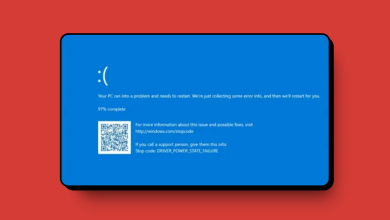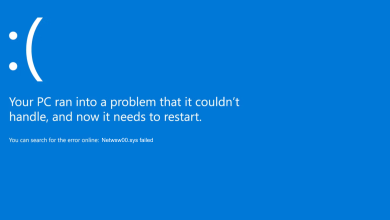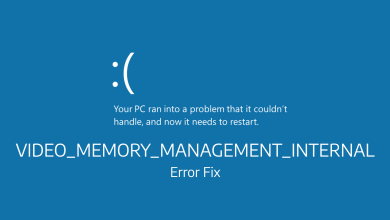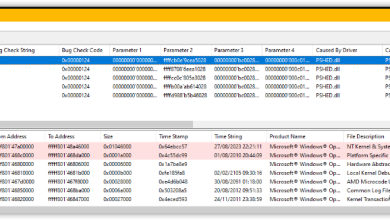How to Fix 0x0000007B BSOD
Several Windows users have been reaching us for help after being stopped from booting up by the 0x0000007B BSOD error. As it turns out, the frequency of this error is higher on Windows version older than Windows 10 (Windows Vista, Windows 7 & Windows 8.1). In broad terms, this particular error seems to occur if the PC suddenly loses access to the system partition during the startup sequence.
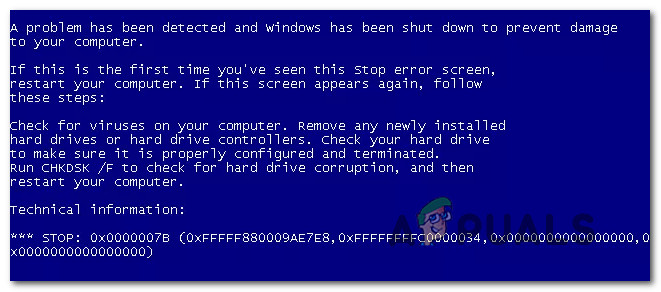
What is causing the 0x0000007B BSOD Error?
We investigated this particular issue by analyzing various user reports and some popular repair strategies that affected users deployed as fixes. As it turns out, there are multiple potential culprits that might be responsible for this error:
- SATA Controller Mode is disabled – This issue might occur if the SATA controller configuration in the system gets toggled from ATA to AHCI mode (or vice versa). Whenever this happens, Windows is unable to communicate with the SATA controller since the two modes are using different drivers and communication channels. If this scenario is applicable, you should be able to resolve the issue by toggling the SATA controller mode inside BIOS settings.
- Second OS HDD is confusing the booting sequence – As it turns out, this issue can also occur if you’ve connected two different HDD or SSD that contain a Windows installation. This has the potential of confusing the Boot manager into triggering this error in situations where there’s nothing wrong. In this case, you should be able to resolve the issue by removing the non-essential HDD/SSD drive.
- AHCI driver is disabled via Registry – Another real possibility is that AHCI or RAID is disabled via a Registry Key, which ends up not enforcing the change even after you change the SATA Controller mode. In this case, you should be able to resolve the issue by modifying a couple of registry value.
- System file corruption – System file corruption can also be the main trigger when it comes to this particular BSOD error code. Several affected users have reported that the issue was resolved after they ran a CHKDSK scan or performed a repair installed (which restored all Windows-related files to the default.
If you’re currently looking for repair strategies to resolve the 0x0000007B BSOD Error, this article will provide you with several different troubleshooting guides. Down below, you’ll find a collection of methods that other users in a similar situation have successfully used to fix this problem.
To remain as efficient as possible, we encourage you to follow the potential fixes in the order that they are presented and skip the methods that are not applicable to your particular scenario. The methods below are ordered by efficiency and each of them is confirmed to work by at least one affected user.
Let’s begin!
Method 1: Enabling SATA Controller Mode in BIOS
A good place to start investigating is to check if SATA controller configuration in the system gets toggled from ATA to AHCI mode (or vice versa). If this scenario is applicable, chances are Windows will not be able to communicate with the SATA controller since the two modes are using different drivers and different communication channels.
Several affected users that we’re also struggling with this issue have reported that they’ve been able to resolve the issue by toggling the SATA controller mode inside their BIOS settings. Here’s a quick guide on how to do this:
- Power up your system and start pressing the Setup (BIOS key) at the initial screen.
NOTE: Typically, the setup key should be displayed on the screen, but in case you missed it you can search online for your specific key according to your motherboard manufacturer.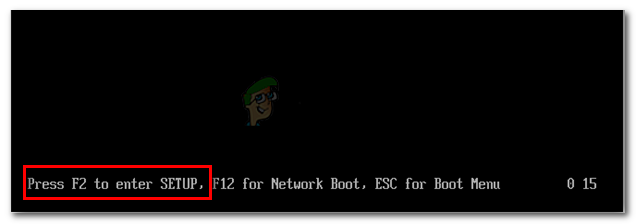
Press the BIOS key during the startup procedure - Once you’re inside your BIOS settings, use the menus to make your way to Advanced > IDE Configuration.
Note: Depending on your BIOS version, your menu may look different. You might also find the menu named IDE Controller or SATA Configuration. - Once you’re inside the IDE Configuration menu (or your BIOS equivalent), change the default configuration menu to AHCI.
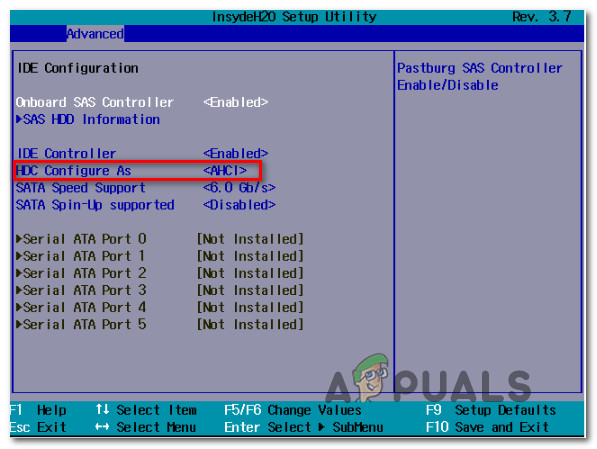
Changing the HDC Configuration of IDE to AHCI - Save your current BIOS configuration and let your PC restart to see if you still get the 0x0000007B BSOD Error. If the error is still not resolved, move down to the next method below.
Method 2: Removing the second HDD/SSD (if applicable)
As it turns out, this particular issue can also occur if have connected two different HDD (or SSD) that contain a Windows installation. In certain cases, this will confuse the Boot manager into throwing the 0x0000007B BSOD Error even in situations where there’s nothing wrong with the system partition.
Several users that are also encountering this issue have reported that the BSOD error was no longer occurring after they removed/disconnected the non-essential HDD drive.
If this scenario is also applicable to your current situation, remove your second HDD or SSD and see if your computer is able to boot up. In the event that the boot-up error no longer appears while the second HDD is disconnected, the only way you’ll be able to use both your HDDs or SSDs is to wipe the non-essential driver and use it as a storage drive only. You can do this easily by following our article on performing a clean install.
In the event that this method wasn’t applicable to your particular scenario, move down to the next method below.
Method 3: Enabling the AHCI driver via Registry
It’s also possible that you’ll start getting a slightly different error message after you make the switch to AHCI or to RAID (STOP 0x0000007B INACCESSABLE_BOOT_DEVICE). In this particular case, the issue will occur if the disk driver on Windows 7 or Windows Vista is actually disabled. To be able to use SATA/Raid mode, you need this driver enabled.
Several users have been able to resolve the issue by using the Registry Editor to enable SATA/RAID mode from a Safe Mode boot. Here’s a quick on how to do this:
- Power on your computer and as soon as you see the initial screen, start pressing the F8 key repeatedly to open the Advanced Boot Options.
- Once you see the Advanced Boot Options menu, use your arrow keys to select Safe Mode (or Safe Mode with Networking) and press Enter.

- Your computer will then restart and reboot into safe mode and wait for the startup sequence to complete.
- Once your PC is fully booted up in Safe Mode, press Windows key + R to open up a Run dialog box. Then, type ‘regedit’ and press Enter to open up the Registry Editor utility. When prompted by the UAC (User Account Control), click Yes to grant administrative privileges.

Running the Registry Editor - Once you’re inside the Registry Editor utility, use the left-hand pane to navigate to the following location:
HKEY_LOCAL_MACHINE\System\CurrentControlSet\Services\Msahci
- When you get to the correct location, double-click on the Start value from the right tab and change the Value data to 0 before clicking Ok.

Modifying the value of MSAHCI via Registry Editor - Use the left pane of Registry Editor to navigate to the following location:
HKEY_LOCAL_MACHINE\System\CurrentControlSet\Services\IastorV
- Move over to the right-pane, double-click on Start and set the Value data to 0 before clicking Ok.
- Close Registry Editor and restart your computer to see if the issue has been resolved.
If the issue is still not resolved, move down to the next method below.
Method 4: Running a CHKDSK scan
It’s also possible that this issue is occurring due to system file corruption. This might end up affecting the booting sequence, which might trigger a 0x0000007B BSOD Error loop. Several affected users have managed to get around this issue by booting their computer into Safe Mode and running a CHKDSK scan.
A Check Disk utility scan will scan the integrity of the file system and system metadata and fix any logical file system errors that it manages to find. This might include corrupt entries in a volume’s master file table (MFT), bad security descriptors or misaligned time stamp or file information.
Here’s a quick guide on running a CHKDSK scan on a computer affected by the 0x0000007B BSOD Error loop:
- Power on your PC and start pressing the F8 key repeatedly during the initial screen to open the Advanced Boot Options.
- Use your arrow keys to select Safe Mode (or Safe Mode with Networking) and press Enter inside the Advanced Boot Options.

- Your computer will then restart and reboot into safe mode and wait for the startup sequence to complete.
- Once your PC is fully booted up in Safe mode, press Windows key + R to open up a Run dialog box. Then, type “cmd” inside the text box and press Ctrl + Shift + Enter to open up an elevated Command Prompt.
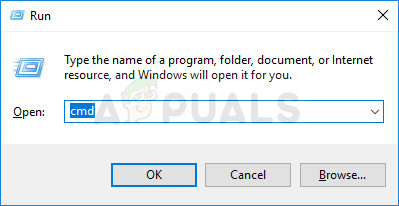
Running administrative Command Prompt from Run dialog box Note: When you’re prompted by the UAC (User Account Control) window, click Yes to grant administrative privileges to the Command Prompt.
- Inside the elevated Command prompt, type the following command and press Enter to initiate a CHKDSK scan:
chkdsk /f
- Wait until the procedure is complete, then restart your computer and see if the issue is resolved at the next normal startup.
If this issue is still occurring, move down to the final method below.
Method 5: Performing a repair install
If you’ve come this far without resolving the issue, a repair install should resolve the issue for good, since it will reset are Windows components including booting-related processes. This procedure is to be preferred instead of a clean install, since it will allow you to reset all Windows components while keeping all personal data (including photos, videos, images, applications or games).
In case you want to go for a repair install, you can follow this article (here) for step by step instructions on how to do so.
